
Deposition Date
2008-03-24
Release Date
2008-06-03
Last Version Date
2024-11-06
Entry Detail
PDB ID:
2VR0
Keywords:
Title:
Crystal structure of cytochrome c nitrite reductase NrfHA complex bound to the HQNO inhibitor
Biological Source:
Source Organism:
DESULFOVIBRIO VULGARIS (Taxon ID: 882)
Method Details:
Experimental Method:
Resolution:
2.80 Å
R-Value Free:
0.26
R-Value Work:
0.22
R-Value Observed:
0.22
Space Group:
P 21 21 21


